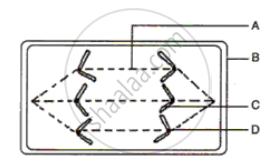Advertisements
Advertisements
प्रश्न
The karyotype (set of chromosomes) shown below is taken from a dividing cell in a certain individual.
(i) Is the individual male or female? Explain your answer.
(ii) How would you expect
(a) a female cell and
(b) sperm cell to differ in chromosome composition?
उत्तर
(i) Male, because there is a Y-chromosome and an X-chromosome.
(ii)
(a) A female would have two X-chromosomes and no Y-chromosome.
(b) A sperm cell would have half the number of chromosomes. 23 instead of 46. There would be only one sex-chromosome which could be either Y or X.
APPEARS IN
संबंधित प्रश्न
With the help of suitable diagrams, explain the five stages of prophase-I of meiosis.
Fill in the blank:
______ takes place in body cells resulting in growth and development.
The diagram given alongside represents a stage in cell division.
Study the same and answer the questions that follow:

(i) Identify the stage of cell division.
(ii) Name the parts labeled A,B,C and D.
(iii) What is the unique feature observed in this stage?
(iv) Where does this type of cell division usually occur?
(v) How many daughter cells are formed from this type of cell division?
(vi) Is the dividing cell shown a plant or an animal cell?
Give a reason to support your answer.
Choose the correct answer:
Which division takes most time?
Explain the Term Pachytene
Mention, if the following statement is True or False. If false rewrite the wrong statement in its correct form:
The alkaloid colchicine inhibits the formation of the mitotic spindle.
Multiple Choice Question:
Karyokinesis is the division of
Write the functional activity of the following structure:
Colchicine
Column ‘II’ is a list of items related to ideas in Column ‘I’. Match the terms in Column ‘II’ with a suitable idea given in Column ‘I’.
| Column I | Column II |
| (i) Anaphase | (a) Chromosomes become arranged in a horizontal plane at the equator. |
| (ii) Prophase | (b) Daughter chromosomes move to opposite poles of the spindle. |
| (iii) Telophase | (c) Chromosomes become visible as fine, long threads. |
| (iv) Metaphase | (d) Chromosomes lose their distinctiveness and gradually become transformed into chromatin network. |
